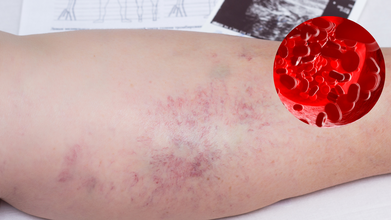- Health Conditions A-Z
- Health & Wellness
- Nutrition
- Fitness
- Health News
- Ayurveda
- Videos
- Medicine A-Z
- Parenting
- Web Stories
Common Do's And Dont's Associated With Pregnancy And Lunar Eclipse

Credits: Canva
A lunar eclipse occurs when the Earth passes between the Sun and the Moon, casting its shadow on the Moon. This alignment only happens during a full moon.
In 2024, there are two lunar eclipses:
The first occurred on March 25, 2024.
The second and final eclipse of the year will take place on Wednesday, September 17-18, 2024.
While the September 17-18 eclipse won't be visible in India, it will be visible in other parts of the world.
Many cultures around the world have specific guidelines for pregnant women to follow during lunar eclipses. These traditions are often rooted in the belief that eclipses can have negative effects on the mother and unborn child.
Here are some common do's and don'ts associated with lunar eclipses and pregnancy:
Do's:
Stay indoors: Some cultures believe that pregnant women should remain indoors to protect themselves and their unborn children from harmful lunar influences.
Relax and rest: It's recommended that pregnant women avoid stress and anxiety during eclipses. Resting can help reduce these feelings.
Cover windows: Some believe that covering windows with thick curtains can shield pregnant women from the negative effects of moonlight.
Take a bath: Bathing before and after an eclipse is believed to purify the body and remove negativity.
Don'ts:
Use sharp objects: It's often advised that pregnant women avoid using sharp objects like knives or scissors during eclipses, as they are believed to be associated with birth defects.
Eat or drink: Some cultures believe that consuming food or water during an eclipse can harm the unborn baby.
Be exposed to lunar light: Direct exposure to lunar light is often considered harmful to pregnant women.
Engage in strenuous activities: Pregnant women are advised to avoid heavy physical activity during eclipses.
It's important to note that there is no scientific evidence to support these beliefs. Many of these practices are rooted in cultural traditions and superstitions.
Disclaimer: Though these practices are rooted in traditions, there are no scientific evidence to support these. We do not promote any unscientific practices. Pregnanct women can choose to follow or disregard these guidelines based on their personal beliefs and comfort level. However, it is always advisable to consult a doctor to discuss any impact on the pregnancy and the unborn child.
Japan Sees Early Flu Season as Virus Evolves, But Health Experts Advise Simple Precautions Over Worry

Japan's flu season has arrived earlier than usual, as a result, this has marked the country's second-earliest start in two decades. As per the reports by Japan Times and South China Morning Post, the health authorities too confirmed that influenza cases have surpassed the one-per-hospital threshold across roughly 3,000 medical institution. This, as official signalled, level is what marked the flu season.
As per Japan's Ministry of Health, Labour and Welfare, an average of 1.04 flu patients were reported per hospital in the week beginning September 22, landing up to Sunday. On October 3, the Health Ministry declared an epidemic after 4,030 people were treated at designated medical institutions. The number show an increase from 957 cases, from the week before that.
Where Are The Cases Rising?
The highest infection rates so far have been seen in Okinawa, averaging nearly nine patients per institution, followed by Tokyo, Kagoshima, and Fukuoka. In contrast, regions such as Tottori and Akita have recorded very few cases. The health ministry has urged residents to take routine preventive steps, washing hands frequently, wearing masks in crowded places, and getting vaccinated.
Read: Japan Flu Outbreak: How Climate Change Has Resulted In The Early Arrival Of Viruses
Is There An Evolving Virus?
Health experts, as reported by South China Morning Post have said that the early wave may suggest that influenza viruses are now evolving. It also mean that they are spreading more easily.
“The flu season has started really early this year, but in the changing global environment, this might become a more common scenario,” said Yoko Tsukamoto, a professor at the Health Sciences University of Hokkaido, in an interview with the media outlet This Week in Asia.
Around 135 schools and childcare centres were temporarily closed in the week Japan treated over 4,000 patients.
What Can Work? Is There A Need To Worry?
Researchers suggest several reasons for this early and rapid spread. One major factor is increased global travel and tourism in the post-pandemic era, which allows viruses to move more freely between populations.
Also Read: 8 Pickleball Warm-Up Exercises To Avoid Injuries, According To Expert
“We are seeing a greater circulation of people, both in Japan and globally, with people taking the virus to new places,” Tsukamoto explained. This constant movement can expose viruses to new environments, and in turn, encourage them to adapt faster.
There is also emerging evidence that indicates that some influenza strains are developing resistance to conventional treatments, a trend that scientists say warrants close observation but not panic. For now, vaccination remains the most effective preventive measure. Tsukamoto noted that while influenza is rarely dangerous for healthy adults, it can pose risks for young children, older adults, and those with chronic illnesses, who should consider getting vaccinated early.
However, experts have pointed out to not worry and follow "common sense precautions". These include good hand hygiene, proper ventilation, mask-wearing in crowded places, and timely vaccination. “For people who are healthy, the flu should not be too dangerous, although it could be unpleasant,” said Tsukamoto.
Lizzo Shares How GLP-1 Drugs And Changing Her Eating Habits Helped Her Achieve Her Weight Goals

(R) Lizzo at the 2022 South by Southwest (Wikimedia Commons) (L) Lizzo shared a photo in January 2025 of achieving her weight goals (Instagram)
Lizzo, American singer and rapper, has always been open about her body and now, her body transformation. In fact, she has openly credited part of her transformation to GLP-1 medication, when she was asked whether she had ever used Ozempic.
"I tried everything," she said in an interview with Trisha Paytas' "Just Trish" podcast.
What Was Lizzo's Weight-loss Journey Like?
Lizzo, 37, has been open about her body transformation, and has in fact shared her weight loss journey publicly to her fans via social media over the last couple of years. In January, she revealed that she had dropped 16% of body fat and lowered her body mass index or BMI by 10.5 since January 2023.
Also Read: 8 Pickleball Warm-Up Exercises To Avoid Injuries, According To Expert
Apart from weight loss drugs, she had also credited her transformation to changing her eating habits and exercising for weight loss.
On Paytas' podcast, Lizzo said, "It's just the science for me- calories in versus calories out. Ozempic works because you eat less food. That's it. It makes you feel full. If you can just do that on your own - mind over matter - it is the same thing."
Two years ago, Lizzo had begun her "intentional" journey to transform her body and in January she celebrated hitting her goal weight.
"I did it," she wrote on her Instagram. "Today when I stepped on my scale, I reached my weight release goal. I haven’t seen this number since 2014! Let this be a reminder you can do anything you put your mind to. Time for new goals!"
Lizzo also told Paytas that while she never felt that doors were closed for her when she was bigger, as she walked down the red carpet at the Met Gala. She felt like her life has improved over the last couple years where she spent on losing weight and achieving her weight goals.
Also Read: Lizzo Shares How GLP-1 Drugs And Changing Her Eating Habits Helped Her Achieve Her Weight Goals
“I feel like I worked really, really hard. It was intentional, what I did with my body. So when I get compliments, I’m like, ‘Thanks, b*tch!’ I really receive it because I need to receive that. I don’t take it any weird way,” she said. “I worked so hard for it. The people who compliment me see me working hard for it — they see me in my calorie [deficit], they see me exercising every day, walking.”
"I do think believe I look good. Everything in my life kind of elevated. It was not just releasing the weight. It was just where I was at in my life, my team. I do feel like I am the baddest. No matter what size, at this point in my life, I am on another level," she said.
What Else Worked Along With Her Weight Loss Journey?
Lizzo also talked about how changing eating habits really helped her. She also talked about some of her new eating habits during a TikTok live. She revealed that she starts with her day with something "super savory" and lets go the "sugary stuff".
She said, if it is something sweet, it has to be with some "sort of like carb. I will have like almond butter and toast."
She also once shared that she used to consume "two to three" large Starbucks drinks a day, which would mean that she drank around 12,000 calories daily. She said that she gave up drinking that after she realized how much calories she was consuming. She also said that giving up coffee also helped her to regulate her nervous system.
Finally, she also praised her skincare routine and Invisalign treatment to make her look her best.
World Thrombosis Day 2025: Theme, Origin, And Significance

Credits: Canva
World Thrombosis Day is a global healthcare awareness day, celebrated on October 13 of each year to increase awareness about thrombosis, including what causes it, the risk factors, indications, symptoms and new treatments.
World Thrombosis Day 2025 Theme
The theme for World Thrombosis Day 2025 is "From Head to Toe, Take Control: Prevent Thrombosis, Protect Your Health".
This theme emphasizes the full-body approach to preventing blood clots and highlights the links between thrombosis and chronic conditions like cancer, diabetes, and heart disease. The campaign aims to empower individuals to take proactive steps for prevention.
World Thrombosis Day Origin
World Thrombosis Day was founded by the International Society on Thrombosis and Haemostasis (ISTH) in 2014, to raise global awareness on this condition and its prevention. This day was also founded to aim to educate the public and the healthcare professionals about blood clots, reduce premature deaths and disability, and promote actions against thrombosis.
Importance of World Thrombosis Day 2025
Before we understand the importance of this day, we must understand what does thrombosis really mean.
What Is thrombosis?
Thromboembolism is a vascular disorder that occurs when a blood vessel becomes blocked by an embolus—a fragment that breaks away from a blood clot. The initial clot formation within a vessel is known as thrombosis. This can happen in veins or arteries, such as in deep vein thrombosis (venous) or coronary artery thrombosis (arterial).
Once a clot forms, it can slow or completely block blood flow and may even travel to vital organs, causing severe complications. Thrombosis is the preventable root cause behind three of the leading cardiovascular killers—venous thromboembolism (VTE), heart attacks, and thromboembolic strokes.
Blood clots can develop in people of any age, gender, or ethnicity, though certain health conditions and risk factors can increase their likelihood. Patients treated with anticoagulants for VTE face about 7.2 major bleeding events and 1.31 fatal bleeding events per 100 person-years, with a 13.4% fatality rate in major bleeding cases.
The annual incidence of venous thromboembolism—which includes deep vein thrombosis (DVT) and pulmonary embolism (PE)—varies with age: around 1 in 100,000 among children, 1 in 10,000 in reproductive-age adults, 1 in 1,000 in middle age, and 1 in 100 among the elderly. Reported rates show pulmonary embolism affects 29–48 per 100,000 person-years, while deep vein thrombosis occurs in 45–117 per 100,000 person-years.
With one in four people worldwide dying from thrombosis or blood clots, World Thrombosis Day aims to raise awareness about this often-overlooked but urgent global health concern.
What Are Some of The Tips To Prevent Blood Clots or Thrombus?
- Maintaining a healthy weight
- Staying active by doing exercise & yoga
- Staying hydrated
- Quitting smoking
- Wearing compression stockings
- Taking breaks during travelling
- Limiting sodium intake
© 2024 Bennett, Coleman & Company Limited

